Internationalization of Higher Education in Japan

Adapted from References by Kristina Parulava.
In today’s circumstances, internationalization plays an essential role in the development of higher education systems and institutions all over the world.
For many countries, the problem of enticing students from abroad can be crucial for whatever reason. One of such countries is Japan, which regards higher education internationalization as a matter of great concern due to some social and cultural hurdles. What challenges in attracting foreign students have Japanese universities been facing over the past years? What efforts have they been making to overcome any obstacles getting in the way to successful internationalization and enhance the international student recruitment process?
Reasons and remedies
Over the past twenty years, Japan has witnessed a considerable decrease in the population of eighteen-year-olds (i.e. young people moving on to tertiary education): from over two million to approximately 1.2 million. Over 40% of private universities find themselves unable to fill their quotas with only Japanese students and focus on recruiting more international students [3].
In 2008 the Ministry of Education, Culture, Sports, Science and Technology (MEXT), and other affiliated divisions of the Japanese government, announced a “300,000 Foreign Student Plan” aiming to increase the number of foreign students in Japan from 140,000 to 300,000 by the year 2020. But the situation was complicated due to Japanese universities’ reputation suffering a relative decline, leading to weakening Japan’s impact on international research, which is reflected in global university rankings [3]. In addition, Japan seemed to lag behind in terms of globalization, partly due to its complacent attitude towards foreign language learning which put the Japanese at a huge disadvantage on the global stage. Foreign students, realizing that the university campuses and students in Japan are not ready to handle global communication at an adequate level, could find it useless to devote their time and resources to such an environment. That is why the Global 30 Project was created to promote internationalization of Japanese higher education. Thirteen top universities participating in the project have been developing English-taught degree programs to encourage foreign students to study in Japan. Besides, Japanese students are supposed to develop their linguistic ability, flexibility, and creativity to be able to communicate and later to compete with foreign peers on an equal footing.

Larry GREENBERG,
CEO of Urban Connections, a language, research and design solutions company based in Tokyo; Head of the affiliate company Digital Meme, which digitizes vintage film for preservation and promotion of Japanese cinema
At the end of 2011, against the background of ongoing socioeconomic issues such as a dwindling number of children and a shrinking workforce, a round table dedicated to the problem of attracting international students to Japan was held [2]. The speakers were Kenji Honma, President of the Hokkaido University of Education, Yohei Otani, General Manager at NEC Soft, Nam-Kung Sung Il, Executive Director at the Tokyo YMCA, Larry Greenberg, CEO of Urban Connections, and Keiko Iwata, President of Heart Connections. Throughout their discussion, the following education-related problems were elicited: the need to bring up truly global human resources to all national universities, Japanese students’ reluctance to study hard compared to the post-World War II period, sending foreign students back after their graduation without satisfying their true needs, too high tuition fees, lack of government, industry and private-sector collaboration in Japan, the Japanese people’s loss of liveliness and confidence in their own country, etc.
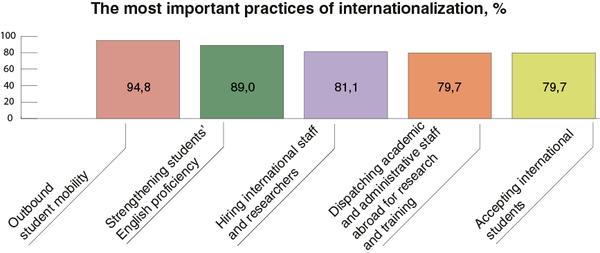
The round table participants proposed the following solutions and strategies to improve higher education internationalization:
- to bring over more outstanding students from overseas,
- to provide financial assistance to some brilliant students who cannot afford their education in Japan,
- to search for excellent staff abroad, consolidation of an official foreign student support system,
- to provide job opportunities to foreign graduates.
Mr. Greenberg also remarked that the Japanese should convey such fine characteristics of theirs like responsibility, common sense and consideration of other people’s feelings to the outside world to make Japan more attractive for foreigners [2].
As a result of efforts made by the Japanese government and universities to ensure effective implementation of the Global 30 Project, the number of foreign students in Japan had increased from 140,000 to 200,000 by 2015. However, the majority of these students have come from China (45% in 2015), presenting a considerable imbalance. In order to achieve true diversity of student population, which will contribute to improvement of Japanese universities’ global competitive standing, it is necessary to pursue an active enrollment policy not only in other parts of Asia, but also worldwide.
Time to count chickens
Now, when the whole internationalization landscape has significantly improved, it is time to sum up what has been done already and to outline what still has to be done in the domain of international collaboration and overseas student recruitment policy. In 2017, the Research Institute for Higher Education at Japan’s Hiroshima University implemented a national survey of 744 university leaders in charge of international activities to discover how they view internationalization. Below are the results from the survey summarized by Futao Huang, Co-Investigator on CGHE’s global higher education engagement research program [1].
First of all, is it important to note that more than half of Japanese universities (58.6%) believe that internationalization is an important agenda at an institutional level.
The most frequently cited goals of internationalization include ’improving the quality and level of research’ (34.3%), ’enhancing university prestige and reputation’ (31.4%) and ’improving staff quality’ (30.8%).
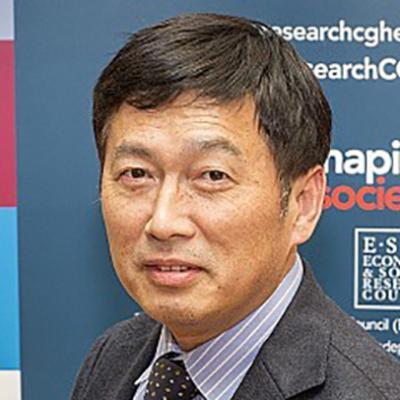
Huang FUTAO,
Co-Investigator on CGHE’s global higher education engagement research program
Survey figures demonstrate a sectoral stratification as to the importance of internationalization: leaders of national universities are more likely (93%) to identify it as integral to the university life than their public (43.4%) or private (43.1%) counterparts.
While both the national and local public sectors aim mostly at improving the quality of research (80.6 % and 41.7% respectively), the primary goal of private universities is to enhance their prestige and reputation (21.4%).
National universities tend to focus on a broad range of these activities, while private universities, in contrast, prioritize the exchange of students and staff with their international partners, particularly attracting foreign students to their campuses.
The benefits of internationalization, in the leaders’ opinion, include international perspectives for both students (95.9%) and staff (90.7%) and ’promotion of international collaboration and partnership’ (89.5%).
Although higher education internationalization is regarded as apparently beneficial by Japanese universities, they identify some risks related to this process.
As to the international status of Japan’s universities, 54.1 % of respondents believe that the research productivity of universities in Japan is in compliance with the international standards, but local public universities are not so sure about it (just 41.7%). According to less than half of respondents, educational activities have already achieved the international standards.
University leaders note that internationalization is beneficial for broadening the international perspectives of students and staff and establishing and developing international partnerships with foreign universities.
Furthermore, in contrast to countries such as Australia, the UK and the US, the internationalization of Japanese universities exhibits strong non-commercial characteristics. This is especially apparent in the case of national universities.
This research also demonstrates significant sectoral variation in attitudes and approaches to internationalization.
In general, the level of national universities’ internationalization is higher than that of local public or private universities, especially in improving the quality of their academic work and research productivity. In contrast, private universities seem to place greater emphasis on broader educational activities and overseas student enrollment on a commercial basis.
The survey results results suggest that increased academic competition worldwide has made Japanese universities realize the need to enhance their competitiveness on the global stage through internationalization, particularly in the field of teaching and research [1].
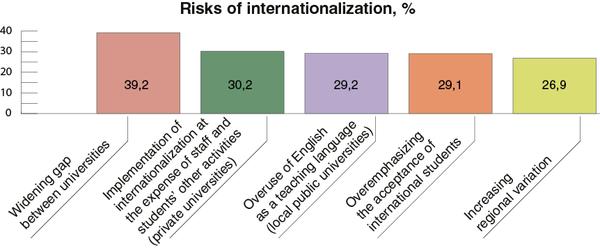
Understated but still efficient
Although the foregoing survey data somewhat understate the role of private universities in research development and teaching quality improvement, while stressing their commercial approach to internationalization, private institutions are an essential part of the modern higher education system in Japan making a substantial contribution to the development of international cooperation and partnership.
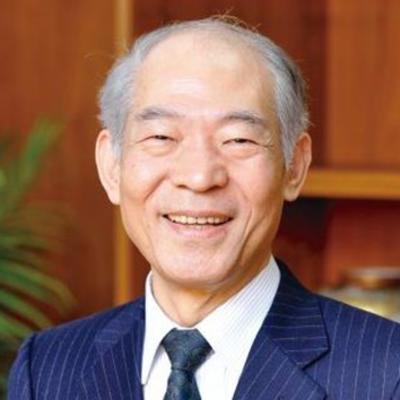
Hitoshi SHIOZAKI,
President of Kindai University, Professor
After obtaining his doctorate in medicine from Osaka University, Professor Shiozaki pursued research in pathology at Heidelberg University in Berlin. Upon returning to Japan, he served at Osaka University for 20 years as Instructor and Assistant Professor. In 2001 Professor Shiozaki accepted a position as Professor and later Director of Surgery at Kindai University Hospital, the Faculty of Medicine, specialising in upper gastrointestinal tract surgery. He has received worldwide recognition for developing new surgical methods that do not damage the vocal cords of esophageal cancer patients. With his research in pathology in Berlin, he made further research findings in the mechanisms of cancer metastasis, earning the Japan Medical Association’s Medical Research Encouragement Prize. As Director of Kindai University Hospital, he has improved the working conditions of female staff by, among other things, creating a nursery in the hospital. Since 2012 he has served as President of Kindai University, Japan.
According to Prof. Hitoshi Shiozaki, President of Kindai University, in 2015, out of the 779 four-year universities in Japan, 604 were private, which demonstrates how important the role of private universities in Japan is. What is more, three quarters of Japanese university students (about 2.1 million) attend universities of this type. Some private educational institutions tend to feel more responsible for providing the high quality education and the social skills that graduates will need to succeed and function effectively in society [3]. Among these is Kindai University famous for its academic excellence and research accomplishments, particularly in medicine. Its research achievements are reflected in international rankings. In order to further improve its position in these rankings, keeping up with globalization, the university have, among other issues, to address foreign language learning programs, international student admissions, and student-faculty ratios; the problems which are common to many Japanese universities.
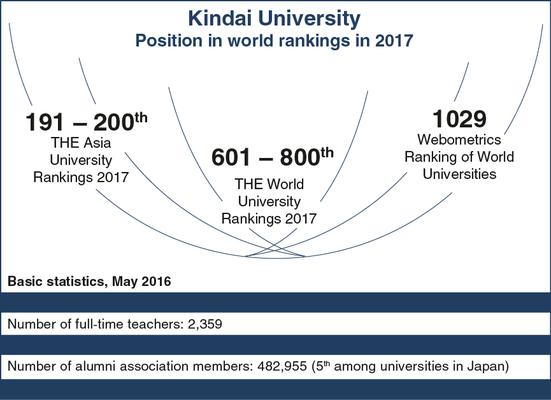
REFERENCES
1. Futao, Huang (August 18, 2017). How do university leaders view internationalization? Centre for Global Higher Education. [Online] Available URL: http://bit.ly/HED2Jp1 / [Accessed September 01, 2017]
2. Round table on attracting foreign students. Experts look at ways to entice overseas talent to study in Japan. The Japan Times. A guide to Japanese universities and colleges. [Online] Available URL: http://bit.ly/HED2Jp2 [Accessed September 01, 2017]
3. QS Asia (by Prof Hitoshi Shiozaki) (June 2017). The transition of the Japanese higher education market and the role of private universities. QS Wownews. [Online] Available URL: http://bit.ly/HED2Jp3 / [Accessed September 01, 2017]